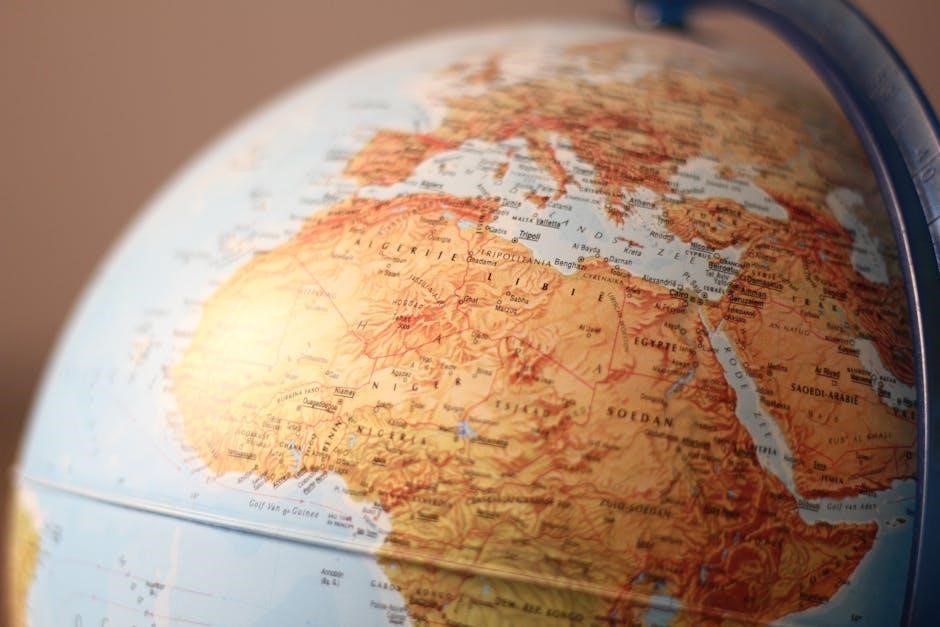Welcome to Unit 1: The Global Tapestry, covering the period from c. 1200 to c. 1450. This guide explores major civilizations, trade networks, governance systems, and cultural exchanges that shaped the world during this transformative era. By mastering these topics, students will gain a deeper understanding of how global dynamics were influenced by key empires, religions, and innovations, preparing them for a successful exam performance.
Overview of the Time Period (c. 1200 ‒ c. 1450)
The period from c. 1200 to c. 1450 was marked by significant global transformations, including the rise and fall of empires, the expansion of trade networks, and the spread of religions. This era saw the dominance of the Mongol Empire, the flourishing of the Islamic world, and the emergence of powerful East Asian dynasties like the Song and Ming in China. Cultural and technological advancements, such as the development of gunpowder and the printing press, also shaped this dynamic period. Understanding these developments is crucial for grasping the interconnectedness of the pre-modern world and its lasting impact on global history.
Key Civilizations and Their Roles in Shaping Global Dynamics
Key civilizations during this period included the Mongol Empire, the Islamic world, and East Asian dynasties. The Mongols established vast trade networks and facilitated cultural exchange. The Islamic world expanded through both conquest and peaceful trade, spreading knowledge and innovations. East Asian civilizations, particularly China under the Song and Ming dynasties, advanced technology and governance systems. These civilizations interconnected the globe, fostering economic, political, and cultural exchanges that laid the foundation for future global dynamics. Their contributions remain vital for understanding the complexity of pre-modern global interactions and their enduring legacies.

Developments in East Asia (c. 1200 ‒ c. 1450)
East Asia witnessed significant advancements in technology, culture, and governance. The Song Dynasty’s innovations in agriculture and maritime trade flourished, while the Ming Dynasty restored imperial authority. Korea and Japan experienced sociopolitical changes, fostering cultural growth and regional trade networks that interconnected with global systems, shaping East Asia’s identity and influence during this period.
The Song Dynasty of China: Innovations and Cultural Achievements
The Song Dynasty (960–1279) was a period of remarkable innovation and cultural flourishing in China. Technological advancements included the invention of gunpowder, the compass, and movable-type printing, which revolutionized global communication and warfare. Economically, the Song Dynasty saw the expansion of maritime trade and the development of a robust monetary system. Culturally, it was a golden age for poetry, painting, and philosophy, with scholars like Su Shi and Zhu Xi making lasting contributions. The capital, Kaifeng, became a center of learning and artistry, embodying the dynasty’s commitment to intellectual and creative progress.
The Rise of the Ming Dynasty and Its Impact on East Asia
The Ming Dynasty (1368–1644) emerged after the collapse of the Mongol-led Yuan Dynasty, marking a resurgence of Chinese power. founder Zhu Yuanzhang established a centralized bureaucracy and revitalized Confucian values. The Ming period saw architectural marvels like the Forbidden City and the Great Wall’s reconstruction. Maritime explorations, such as Zheng He’s voyages, showcased Chinese dominance. However, the Ming also implemented isolationist policies, limiting foreign trade and closing the Silk Road, which impacted regional stability and encouraged neighboring states like Japan and Korea to adapt their strategies, reshaping East Asia’s political and cultural landscape during this period.
Korea and Japan: Sociopolitical Developments During This Period
Korea and Japan experienced significant sociopolitical changes from c. 1200 to c. 1450. In Korea, the Goryeo Dynasty faced challenges from Mongol invasions, leading to the eventual rise of the Joseon Dynasty in 1392, which emphasized Confucianism and cultural advancements. Japan saw the decline of the Kamakura Shogunate and the rise of the Ashikaga Shogunate, marked by the Nanboku-chō period’s political fragmentation. The samurai class solidified its influence, while Zen Buddhism flourished, shaping Japan’s cultural identity. Both nations navigated external pressures and internal reforms, fostering distinct yet interconnected paths in East Asia during this transformative era.

The Islamic World and Its Expansion
The Islamic World expanded significantly from 1200 to 1450 through trade and military campaigns, spreading Islam, fostering cultural exchanges, and establishing a vast, interconnected network.
Causes and Consequences of Muslim Rule Expansion Before 1450
Muslim rule expanded due to military campaigns, trade networks, and Sufi missionary activities. Conquests in West Africa and India spread Islam, while cultural exchanges flourished. The establishment of administrative systems and the blending of local traditions with Islamic practices created a lasting legacy. This period saw the diffusion of Islamic knowledge, art, and science, shaping global cultures and societies. The expansion also facilitated economic growth and interconnectedness, leaving a profound impact on the pre-modern world.
West African and Indian Contributions to Islamic Expansion
West Africa and India played pivotal roles in Islamic expansion through trade and cultural exchange. West African kingdoms, connected via trans-Saharan routes, facilitated the spread of Islam peacefully through merchants and scholars. India experienced Islamic influence through invasions and Sufi missionaries, blending local traditions with Islamic practices. Both regions contributed to the rich cultural and intellectual tapestry of the Islamic world, enriching its legacy in art, science, and spirituality. Their integration into the Islamic network highlights the diverse and interconnected nature of global dynamics during this period.
The Role of Sufism in Spreading Islam
Sufism emerged as a powerful spiritual movement within Islam, emphasizing inner devotion and mystical practices. Sufi mystics and poets played a crucial role in spreading Islam through their teachings and emotional connections with people. By focusing on love, tolerance, and spirituality, Sufism attracted diverse populations, fostering peaceful conversion and cultural blending. Their approach complemented the expansion of Islamic rule, particularly in regions like India and sub-Saharan Africa, where Sufi practices resonated deeply with local traditions. This mystical dimension of Islam not only expanded its reach but also enriched its cultural and intellectual heritage globally.

The Mongol Empire and Its Global Influence
The Mongol Empire, established by Genghis Khan, expanded through military prowess, creating the largest contiguous empire in history. Their rule facilitated trade and cultural exchange, shaping global connections.
Expansion and Conquests: How the Mongols Shaped Global Politics
The Mongol Empire, under Genghis Khan and his successors, expanded rapidly, creating the largest contiguous empire in history. Through military brilliance and strategic alliances, they conquered vast territories, including China, Central Asia, Eastern Europe, and the Middle East. Their campaigns reshaped global politics by connecting disparate regions under a single imperial system. The Mongols’ administrative innovations, such as the decimal military organization and merit-based leadership, ensured stability across their vast domains. Their conquests facilitated political centralization and cultural exchanges, leaving a lasting legacy on global governance and international relations.
Economic and Cultural Exchanges Facilitated by the Mongols
The Mongols facilitated extensive economic and cultural exchanges by unifying vast regions under their rule. They reopened and expanded the Silk Road, connecting Europe, Asia, and Africa, and promoted trade of goods like silk, spices, and porcelain. Cultural exchanges flourished as ideas, technologies, and religions spread across their empire. The Mongols’ tolerance of diverse cultures allowed for the blending of traditions, fostering a rich cultural legacy. This period of exchange laid the foundation for global interconnectedness, enriching societies economically and culturally while shaping the modern world’s cultural tapestry.
Trade Networks and Their Significance
Trade networks, such as the Silk Road and maritime routes, connected distant regions, fostering economic prosperity and cultural exchange. These pathways were vital for the global spread of goods, ideas, and innovations during this period.
The Silk Road and Its Role in Global Trade
The Silk Road was a vast network of trade routes connecting East Asia to the Mediterranean. It facilitated the exchange of goods like silk, spices, and tea, while also spreading technologies, religions, and cultures. Merchants and travelers carried not only commodities but also ideas, fostering cross-cultural interactions and economic prosperity. The Silk Road played a pivotal role in establishing global trade systems, linking major civilizations and shaping the world economy during the period from c. 1200 to c. 1450.
Maritime Trade Routes and Their Impact on Cultural Exchange
Maritime trade routes flourished during the period c. 1200 to c. 1450, connecting regions such as Southeast Asia, the Indian Ocean, and the Mediterranean; These routes facilitated the exchange of goods like spices, porcelain, and textiles, while also enabling the spread of ideas, religions, and technologies. The advancements in ship design and navigation, such as the Chinese junk, played a crucial role in this era. Maritime trade not only boosted economies but also fostered cultural exchange, blending traditions and practices across civilizations. This interconnectedness laid the foundation for a more globalized world, influencing societies far beyond the immediate trading partners.

Systems of Governance and Their Evolution
During c. 1200 to c. 1450, systems of governance evolved significantly across civilizations. China’s centralized bureaucracy under the Song and Ming dynasties emphasized meritocracy and administrative efficiency. The Islamic world adopted decentralized caliphates and sultanates, blending religious and political authority. Empires like the Mongols implemented flexible, adaptive governance structures. These systems influenced the development of legal frameworks, taxation, and administrative techniques, shaping the foundations of modern governance and leaving a lasting legacy in global political structures.
Chinese Dynasties: Systems of Government and Their Development
The Song Dynasty (960–1279) established a centralized bureaucracy, relying on a merit-based civil service exam system to select officials. This system emphasized education and intellectual prowess, fostering a professional administrative class. The Ming Dynasty (1368–1644) further refined this model, strengthening imperial authority and centralizing power. Both dynasties utilized a hierarchical structure, with local governments overseen by centrally appointed officials. Legal codes and administrative reforms, such as the development of the “Grand Secretary” role, reinforced state control. These systems laid the foundation for efficient governance in China, blending tradition with innovation to maintain stability and order during this period.
Comparative Analysis of Governance in Major Civilizations
During the period c. 1200–c. 1450, governance systems varied significantly across major civilizations. China under the Song and Ming dynasties utilized a centralized bureaucratic system with civil service exams, emphasizing meritocracy and administrative efficiency. In contrast, the Islamic world relied on caliphates and sultans, blending religious and political authority. The Mongol Empire employed a decentralized khanate system, prioritizing military organization and flexibility. While these systems differed in structure, they all sought to maintain order, consolidate power, and adapt to the challenges of their respective eras. This comparative analysis highlights the diversity and ingenuity of governance during this transformative period.

Religious and Cultural Developments
The period c. 1200–c. 1450 saw the spread of major religions like Buddhism, Christianity, and Islam, alongside cultural advancements in art, literature, and architecture, leaving a lasting legacy.
The Spread of Major Religions During This Period
Buddhism expanded in East Asia, gaining prominence in China, Korea, and Japan through trade and cultural exchanges. Christianity solidified its presence in Europe, while Islam spread rapidly across the Middle East, North Africa, and parts of Asia and Europe. The Islamic expansion was driven by both military campaigns and peaceful conversions, facilitated by trade networks and Sufi missionaries. This period also saw syncretism, as religious practices blended with local traditions, creating diverse expressions of faith. These developments deeply influenced cultural, political, and social structures, shaping the global tapestry of religious identity during this transformative era.
Cultural Achievements and Their Legacy
The period c. 1200 ‒ c. 1450 witnessed remarkable cultural achievements that left a lasting legacy. In China, the Song Dynasty advanced printing technology, fostering intellectual growth. Islamic scholars preserved and expanded Greek knowledge, influencing European scholarship. Sufi poets and thinkers enriched Islamic culture, promoting spiritual and philosophical inquiry. In East Asia, Zen Buddhism flourished in Japan, while Korea developed sophisticated celadon pottery. These advancements not only defined the cultural landscape of the time but also laid the foundation for future innovations, shaping the global exchange of ideas and artistic expression for centuries to come.
Master key themes, practice essay questions, and review timelines. Focus on global interactions, cultural developments, and systems of governance to excel on the exam. Stay organized and confident!
Key Concepts to Focus On for the Exam
Focus on major civilizations like China, the Islamic World, and the Mongol Empire. Understand trade networks, religious spread, governance systems, and cultural exchanges. Analyze impact of empires, innovations, and interactions between regions. Pay attention to specifics such as the Song and Ming Dynasties, Sufism, and the Silk Road. Practice identifying patterns and changes over time to answer both multiple-choice and essay questions effectively. Prioritize understanding causation and global dynamics to excel on the exam.
Effective Study Strategies for Mastering the Material
To excel in Unit 1, create a structured study plan focusing on key concepts. Use active reading techniques and take detailed notes on major civilizations, trade networks, and governance systems. Highlight and review key terms regularly. Engage with practice questions to test understanding. Utilize flashcards for memorization of dates, empires, and cultural developments. Participate in group discussions to deepen comprehension. Prioritize analyzing primary sources and comparing historical events. Regularly summarize chapters to reinforce learning. Stay organized and review material consistently to ensure mastery of the Global Tapestry.
